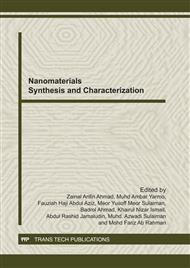p.20
p.25
p.30
p.35
p.40
p.45
p.50
p.55
p.60
Analyses of Heavy Metal Content in Different Particles Size of Centella asiatica
Abstract:
Arsenic (As), Cadmium (Cd) and Lead (Pb) are the heavy metal and categorized as high toxicity compound. This element can be found in the animal and plant from bio accumulation mechanism. This bio accumulation will lead to the toxicity when its concentration surpasses regulated value. Centella asiatica is a plant belonging to the Umbelliferae family, hydrocotyle order, which has been used for curing of venous ulcers and venous hypertension for its activity on connective tissue metabolism and endothelial integrity. This plant also widely used in formulation of drugs and cosmetic. In order to produce high quality herbal product, the characterization and standardization of heavy metal content using modern technique must be carried out. Centella asiatica nanopowders were produced at different grinding condition and analyzed for As content using ICP-OES (Optima 7300 DV, Perkin Elmer). The confirmations of size were carried out using nanoZeta Sizer S (Malvern Instrument) and Field Emission Scanning Electron Microscope. The results obtained show that As, Cd and Pb presence in all type of grinding below the acceptable daily intake by the world health organization (WHO).
Info:
Periodical:
Pages:
40-44
Citation:
Online since:
October 2011
Authors:
Keywords:
Price:
Сopyright:
© 2012 Trans Tech Publications Ltd. All Rights Reserved
Share:
Citation:


